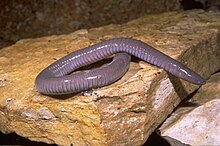Dermophis mexicanus
| Mexican burrowing caecilian | |
|---|---|
 |
|
| Scientific classification | |
| Kingdom: | Animalia |
| Phylum: | Chordata |
| Class: | Amphibia |
| Order: | Gymnophiona |
| Family: | Dermophiidae |
| Genus: | Dermophis |
| Species: | D. mexicanus |
| Binomial name | |
|
Dermophis mexicanus (Duméril & Bibron, 1841) |
|
The Mexican burrowing caecilian (Dermophis mexicanus) is a species of limbless amphibian in the family Dermophiidae. It is found in Mexico and Central America, where it burrows under leaf litter and plant debris.
The adult Mexican burrowing caecilian grows to a length of 30 to 50 cm (12 to 20 in). In general appearance, it resembles a large earthworm. Around a hundred transverse annular folds in the skin give the appearance of segments. The head has a pointed snout, a single row of teeth in the lower jaw, and two vestigial eyes covered with skin, with a pair of protrusible tentacles between the eyes and the nostrils. The body is elongated and there are no limbs. The upper surface is dark grey and the under surface pale grey with darker markings on the annuli.
The Mexican burrowing caecilian is found in Mexico, Guatemala, El Salvador, Honduras, Nicaragua, and possibly Belize, mostly on the Atlantic side, but also in some isolated parts of the Pacific slope. Its natural habitats are subtropical or tropical dry forests, moist lowland forests, moist montane forests, plantations, rural gardens, and heavily degraded former forests. It is fossorial, living in damp, loose soil and under leaf litter, logs, and plant debris, often in banana and coffee plantations. It is found at altitudes of up to 1,200 m (3,900 ft) above sea level.
The Mexican burrowing caecilian feeds on invertebrates, including earthworms, termites, crickets, slugs, and snails. It emerges onto the ground surface on nights with light rainfall and catches small prey that come within its reach. Larger individuals may eat mice and small lizards. It moves by internal concertina-like movements and by undulating its body from side to side.
...
Wikipedia

